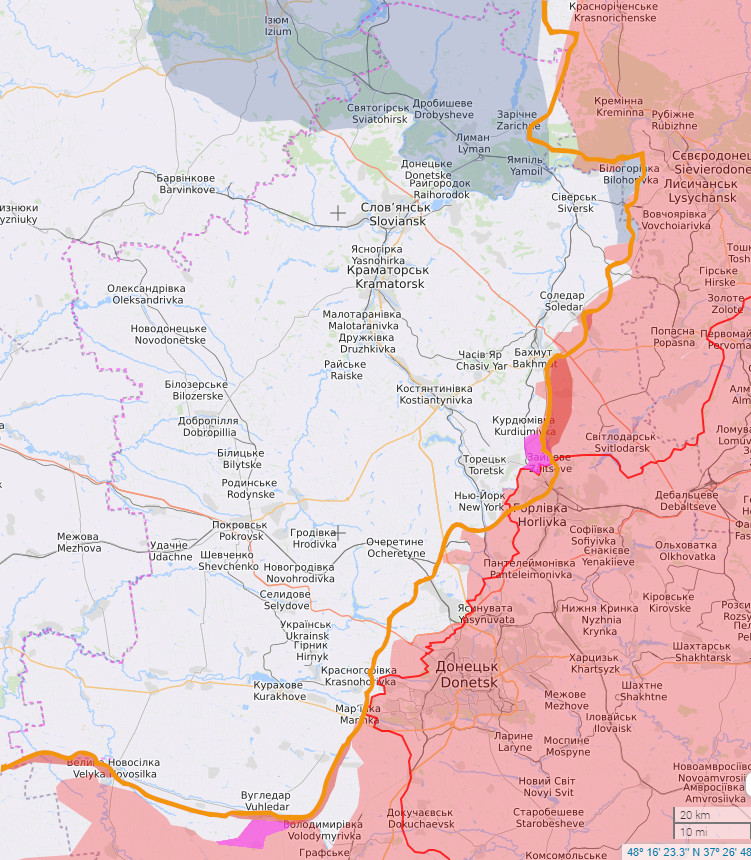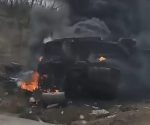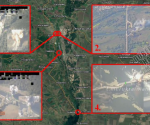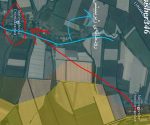Russian progress in Donetsk as at 13th November
This site has been tracking Russian progress in Donetsk since July 27th (in the first report published August 9th), and there isn’t a single occasion when the maps used for reference did not show an advance. If the reader is interested, a list of the five previous articles in which the progress has been recorded is to be found at the foot of the page.
In this instalment, as per what has become a custom, the image below indicates the extent of Russian control – according to a map published with the Russian Ministry of Defence briefing on this day – with the thicker orange line. As is usually the case, this line is superimposed on a map by the Ukrainian-sided liveuamap.com, also produced on 13th November.
Whereas in the past a blue line has been used to indicate Russian gains as acknowledged by the Ukrainians, in this instalment (and perhaps going forward), this feature is shown by the purple shading. The Russian gains thusly shown have occurred since the 28th October, which is the date that the Ukrainian reckoning was last noted.
In another change of practice, the red shading under the orange line shows a shift in the Russian version of the front line since the last time that its reckoning was noted (27th October) – as best as the author can ascertain is significant. To explain, the original Russian maps, being as though a rendering of an ordnance survey type chart as they are, are not easy to translate on to their digital counterparts because of how they become pixelated on zooming, and because they do appear to be much older charts (showing features that have since changed). In addition, the Russian originals are always cluttered with annotations. Indeed, as the reader might notice, the author has only now been able to clearly ascertain how the Russians see the situation in the north of Donetsk.
Generally, the exercise of translation to extract the orange line sometimes produces tiny variances although, as has been explained previously in one of these presentations, there is general consistency from one production to another. That being said, the author is confident that the Russians have indicated they are edging forward uniformly in the southeast corner of the theatre [between Pavlovka† and Vuhledar (Ugledar) and Marinka (Maryinka)], and around Velyka Novosilka near the Zaporozhye border.
Very noticeable is the territory said to be gained from (near) Kurdiumivka to Bakhmut (Artyomovsk) – in fact, the Russians are at last affirming that which the Ukrainians have already been attributing to them, as is the case near Soledar.
Not for the first time, the author must explain that he has no explanation about the situation to the north and west of Donetsk city, and how it appears to be contradicted by recent social media reckoning of the recent Russian gain of Opytne, for instance. Opytne sits between Donetsk and Avdiivka, which is the urban sprawl in grey that projects from liveuamap’s red shading at Yasynuvata. Indeed, according to the social media legends, Avdiivka is largely yet to be captured by the Russians. The author has no other defence for the placement of the orange line in relation to Avdiivka than that the Russian MoD consistently includes the town within its area of control on its maps. Naturally, it wouldn’t get translated into the graphic if that wasn’t the case.
† Pavlovka was the setting for another psychological operation involving “pro-Russian” Telegram channels (reportedly, the one called The Grey Zone was the chief miscreant) creating or channelling material to be picked up to be used as propaganda by major Mi7 outlets. After reports on November 5th/6th of heavy fighting and unusually high Russian casualties, as the story goes in nothing less than the Daily Mail, “marines from Russia’s 155th Naval Infantry Brigade wrote a scathing letter to their regional governor, claiming they had lost 300 servicemen in a four-day massacre”. Later, the story was debunked not only by the marines themselves, but also by the governor, Oleg Kozhemyako, who indicated to the Russian Tass news agency that the authorities were involved, presumably meaning in connection with upholding Russia’s law on spreading disinformation about the SMO.
August 9th: Russian Progress In The Territory Of The Donetsk People’s Republic (link)
September 7th: Putting The Kherson Bluff Into Perspective: A Month Of Real Russian Gains In Northern Donetsk (link)
September 27th: The Russian Partial Mobilisation Is But A Component In What Was Always An Inevitability (link)
October 8th: Russian Gains And Ukrainian Losses In Donetsk, 1st September To 7th October (link)
November 1st: While AFU Resorts To Using Cars And Mi7 Propaganda Projects Other Terminal Ukrainian Weakness, Russia Continues To Take Donetsk (link)



















